|
|
Celestron C14 EdgeHD Optical Analysis
Wade Van Arsdale
Little Rock, AR., USA
November 26th, 2010
|
|
(Shown above with AstroZap Aluminum Dewshield)
**NEWLY UPDATED C14 EDGE HD INFORMATION**: See updated information here about C14 EdgeHD thermal issues and how to help alleviate them. Updated Strehl testing also available at this link.
I. Optical Analysis:
Strehl and Wavefront Error Testing
Test Date: November 26th, 2010
Test Site: C.A.A.S. East Observatory, Little Rock, AR., el. 650 ft.
Skies: Clear
Seeing: 8 out of 10
Transparency: 9 out of 10
Temperature: 42 degrees F
Dewpoint: 30 degrees
Wind: N, 5 mph
OTA: 2010 Celestron C14 EdgeHD SCT Telescope
OTA Cooling Method: Passive, original factory setup with no forced fan
cooling. 2 hour cool-down period prior to testing.
Test camera: Lumenera SKYnyx 2-2C webcam with Baader IR/UV cutoff filter @
320 x 240 image size, 46 fps capture rate for 1000 frames, and resolution
of 0.23 arc-sec/pixel
Reference
Chart for Strehl Values and P-V Wavefront Errors. Chart courtesy of R.F.
Royce Precision Optical Components:
|
Commonly Encountered Wavefront Relationships |
||||
| P-V Fraction | P-V Decimal | Marechal RMS* | Strehl Ratio | Comments |
| 1/3 | .333 | .094 | .71 | |
| 1/4 | .250 | .071 | .82 | Rayleigh Limit |
| 1/5 | .200 | .057 | .88 | |
| 1/6 | .167 | .047 | .92 | Good |
| 1/7 | .143 | .041 | .94 | Very Good |
| 1/8 | .125 | .036 | .95 | Excellent |
| 1/9 | .111 | .032 | .960 (.96) | Excellent |
| 1/10 | .100 | .028 | .969 (.97) | Excellent |
| 1/11 | .091 | .026 | .974 | |
| 1/12 | .024 | .024 | .978 | "Super Apo" |
Strehl
Test Results:
| GREEN (reference): Strehl Test for mid-bandwidth reference (Green--approx. 550nm wavelength) Summary: The Strehl tested at an excellent 0.939, which corresponds to a P-V wavefront error at the camera chip of 1/7th wave, which is very good, especially for a compound-mirror system. The glass is almost perfectly corrected in the Green bandwith, with some OTA internal thermals around the left glass edge in the side vent area of the tube that are present in the Ronchigram image (the black and white test pattern below). Some type of forced cooling with fans would help this OTA's performance significantly . 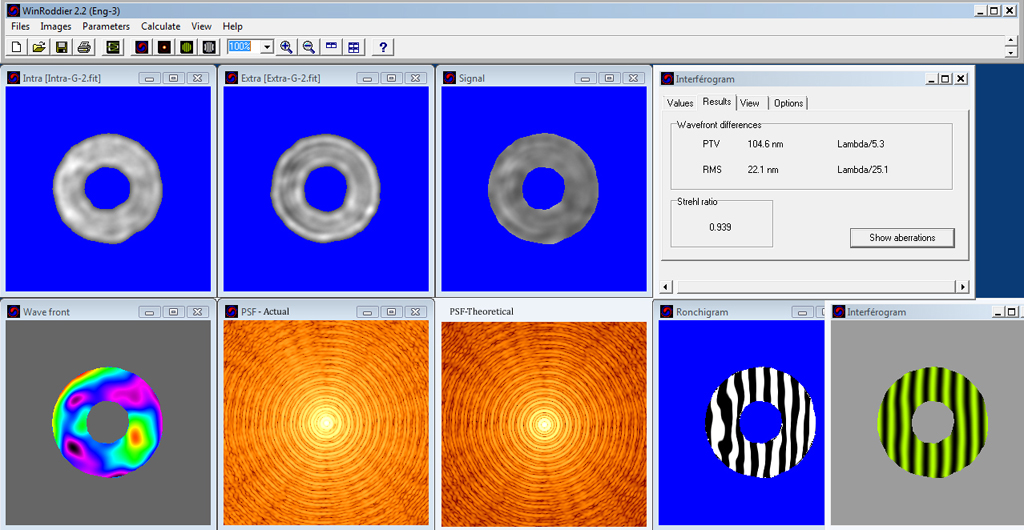
|
| RED: The glass is slightly undercorrected in the Red bandwith, but still better than diffraction-limited, with a Strehl value of 0.872, which corresponds to a P-V wavefront error of slightly worse than 1/5th wave. The undercorrection in Red will tend to correct itself slightly as the glass temp cools and the glass reaches thermal equilibrium with the outside air. 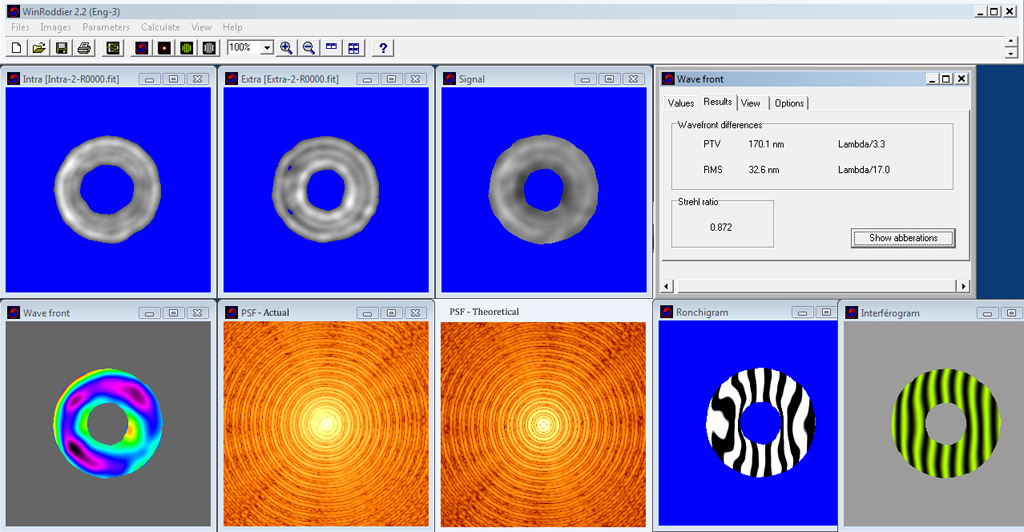
|
| BLUE: The scope tested out as better-corrected in the Blue bandwidth than the Red bandwith, but worse than the Green bandwidth. Blue bandwidth Strehl was 0.899, which is still better than diffraction-limited at 1/5th wave P-V, at the camera chip. The telescope is slightly overcorrected in Blue. This overcorrection in Blue will be the primary weakness in the OTA's performance, but will go mostly unnoticed for visual work since the wavefront in Blue is still significantly better than diffraction-limited and the human eye is relatively insensitive to the far-Blue bandwidth. It could be a factor though for CCD imaging and hurt sharp star focus slightly, especially with one-shot color CCD cameras and color DSLR's. But the effects of it should be very minor for photography overall, especially for mono cameras where refocusing is done with each color filter change. The scope overall has very good glass figure and should be a very good performer for both visual astronomy and CCD imaging. 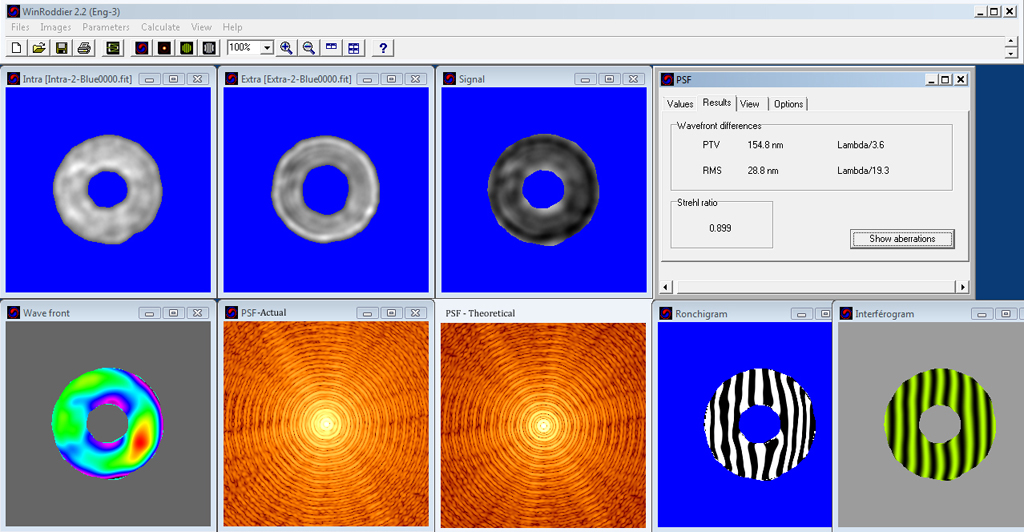
|
II. Zernicke
Polynomials:
In this section, we examine the optical
alignment, astigmatism, collimation, and spherochromatic aberration of the
optics. The star used for the test was at a sky altitude of more than 80
degrees to help insure least possible interference in the results from
atmospheric effects and blue extinction. Green was used as the reference
bandwidth for these Zernicke comparisons.
Strehl
with all optical figure and alignment defects included: 0.939
Strehl, or 1/7th wave.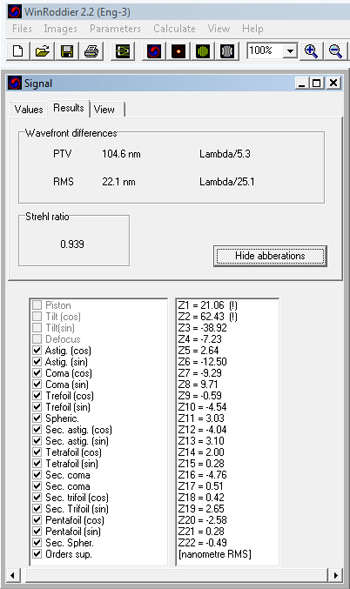
|
Strehl
with Coma removed from the measurements: 0.960
Strehl,
or an excellent 1/9th wave.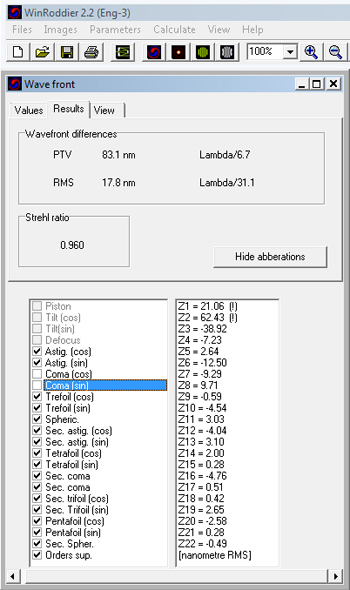 The coma is due mostly to slight mis-collimation of the secondary mirror which is correctable using the OTA's three collimation screws. This mis-collimation is also seen in the "PSF-Actual" image in the above section. There is slightly more light energy in the center core toward the 9:00 position. Some coma may also be coming very slightly from decentering of the secondary to primary mirror axis, which is not end-user correctable without disassembly and fine-centering using the peripheral corrector plate adjustment screws of the OTA and laser alignment of the two mirrors on a lab bench. Not enough error on this scope to need to fix that however. |
Strehl
with Asigmatism removed: 0.959 Strehl, or 1/9th wave. 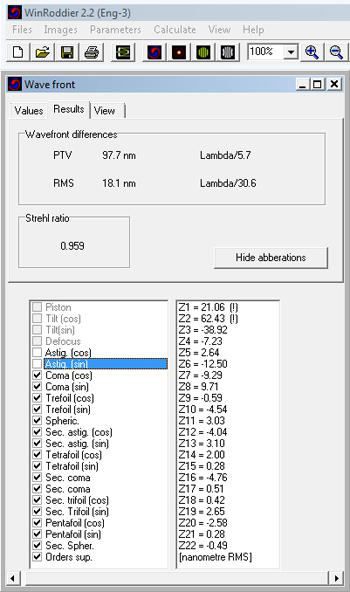 Astigmatism is likely due to slight tip-tilt error of primary mirror in relation to the optical axis. This could be caused by the typical SCT primary mirror "flop". Some slight astigmatism may be coming from the glass figure as well. It could also be caused by thermal flux of the glass as it cools to ambient temp. |
| Strehl
with Spherical Aberration removed: 0.940 Strehl, or 1/7th wave. 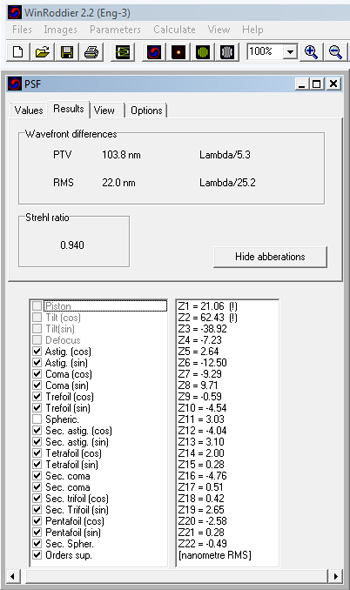 The telescope shows very little SA, indicating excellent glass figure and corrector glass accuracy. However, the polychromatic SA is expected to be slightly worse on this sample due to the slightly miscorrected Red and Blue wavelengths. |
Strehl
with all major alignment defects removed: 0.981
or 1/12 wave.Excellent glass quality!!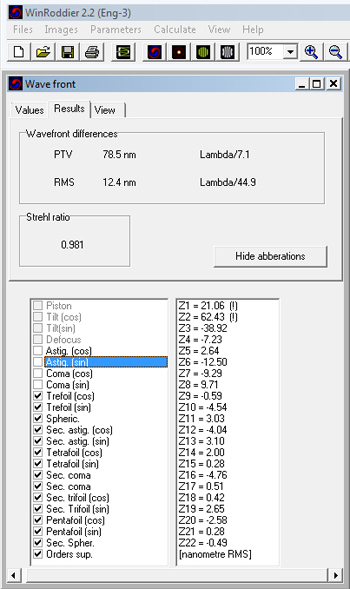 Overall, the glass quality on this unit is excellent. Most of the wavefront error is from user-correctable mis-collimation and OTA thermals. |
III. Hi-resolution webcam image of Jupiter with the Celestron C14 EdgeHD:
Date: November
27th, 2010
Telescope: Celestron C14 EdgeHD
Atmospheric Seeing Conditions: Average at best for this location, with
FWHM values ranging from 2.2 to 2.5 arc-sec during the imaging session.
Camera: Lumenera SKYnyx 2-2C webcam with Baader UV/IR cutoff filter
@ 22 fps capture rate for 1000 frames, and Televue 2x
Powermate for a final resolution of 0.115 arc-sec/pixel @ f/22.
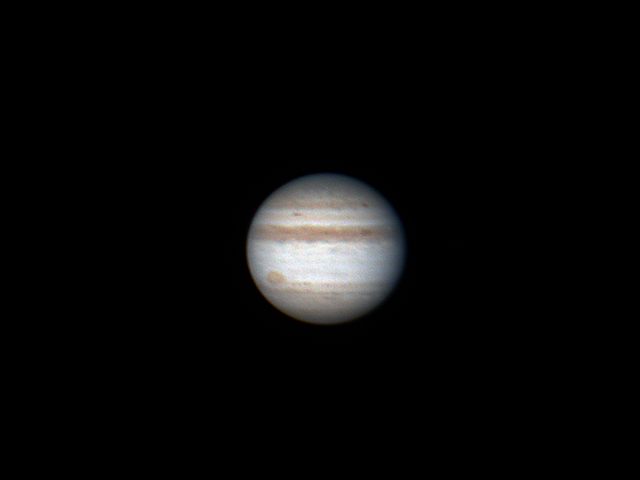 |
Conclusions:
The
C14 EdgeHD tested out with a very good Strehl value of 0.939, as measured
mid-bandwidth in the Green (approximately 550 nm wavelength). This
corresponds to a glass quality of approximately 1/7 wave, which is very good and
well beyond the diffraction limit of 1/4th wave (0.82 Strehl). This means that in all types of atmospheric seeing conditions
no matter how good, the telescope's performance will only be limited by its
level of collimation, the
central obstruction effects from the primary mirror assembly, the
atmospheric seeing conditions, and by correctable tube thermals inside the OTA
itself, and never limited by the telescope's glass quality.
t
Some
slight astigmatism is present in the Roddier results but was not detected in the
visual star tests. This residual astigmatism is likely due to slight
tip/tilt error between the primary and secondary mirrors that could be from
primary mirror "flop".
Spherochromatic aberration is almost zero in this sample, indicating that the front corrector glass is of excellent quality and has been installed and positioned very accurately at the factory. Most of the coma seen in the tests is due to a slight miscollimation toward the 9 o'clock angle that is easily user-correctable. The amount of coma that is due to positional decentering of the secondary mirror in relation to the primary is very small. (Verified on later tests that can be viewed here).
The telescope is very neutrally corrected in the Green wavelengths, less corrected in the Blue bandwidths, and the least well-corrected in the Red bandwidths. The telescope tested out at 0.872 Strehl in the Red bandwidth and 0.899 Strehl in Blue. The glass is slightly undercorrected in the Red wavelengths and slightly overcorrected in the Blue bandwidth. This condition should self-correct slightly in the Red wavelengths as the glass continues to come to equilibrium with the outside air temperature. The telescope is best-corrected in the Green wavelength, which is the most important bandwidth for visual astronomy.
The visual testing so far has confirmed the Roddier results, with the telescope giving very good focus sharpness and good fine contrast and detail on planetary visual observations when the OTA has been force-cooled to ambient temp by the use of a temporary front fan just prior to observing. The fan, while essential for best planetary performance, has not proven to be needed so far for good deep-sky use.
Wade Van Arsdale
November 29th, 2010
Little Rock, AR., USA